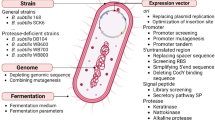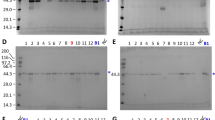Abstract
The effect of the removal of signal peptides after cleavage of precursor molecules by the signal peptidase I was examined in an in vitro translocation system with Escherichia coli membrane vesicles. The translocation of periplasmic alkaline phosphatase precursors was significantly inhibited by the protease inhibitors antipain, elastatinal and leupeptin. Antipain and leupeptin enhanced the translocation of precursors of outer membrane protein OmpA, but inhibited the processing. However, antipain did not inhibit the processing of precursors mediated by signal peptidase I in the soluble form. Moreover, the inhibition by antipain was not due to the disruption of membrane integrity, but occurred during the process of protein translocation. Since these small peptide inhibitors are known to inhibit membrane protease IV, a signal peptide peptidase, these results suggest that the hydrolysis of signal peptides is an important step in the recycles of the overall translocation process, and that the prevention of degradation of signal peptides feedback inhibits the preceding steps in the translocation pathway.
Similar content being viewed by others
References
BensonSA, HallMN, SilhavyTJ (1985) Genetic analysis of protein export in Escherichia coli K-12. Annu Rev Biochem 54: 101–134
BriggsMS, GieraschLM (1984) Exploring the conformational roles of signal sequences: synthesis and conformational analysis of λ receptor protein wild-type and mutant signal peptides. Biochemistry 23: 3111–3114
CabelliRJ, ChenLL, TaiPC, OliverDB (1988) SecA protein is required for secretory protein translocation into E. coli membrane vesicles. Cell 55: 683–692
ChenL, RhoadsD, TaiPC (1985) Alkaline phosphatase and OmpA protein can be translocated posttranslationally into membrane vesicles of Escherichia coli. J Bacteriol 161: 973–980
ChenLL, TaiPC (1985) ATP is essential for protein translocation into Escherichia coli membrane vesicles. Proc Natl Acad Sci USA 82: 4384–4388
ChenLL, TaiPC (1987) Effects of antibiotics and other inhibitors in ATP-dependent protein translocation into membrane vesicles. J Bacteriol 169: 2373–2379
ChenLL, TaiPC, BriggsMS, GieraschLM (1987) Protein translocation into Escherichia coli membrane vesicles is inhibited by functional synthetic signal peptides. J Biol Chem 262: 1427–1429
ChungHC, GoldbergAL (1983) Purification and characterization of protease So, a cytoplasmic serine protease in Escherichia coli. J Bacteriol 154: 231–238
CollierDN, BankaitisVA, WeissJB, BassfordPJ (1988) The antifolding activity of SecB promotes the export of the E. coli maltose-binding protein. Cell 53: 273–283
CrookeE, WicknerW (1987) Trigger factor: a soluble protein that folds pro-OmpA into a membrane-assembly competent form. Proc Natl Acad Sci USA 84: 5216–5220
DevIK, RayPH (1984) Rapid assay and purification of a unique signal peptidase that processes the prolipoprotein from Escherichia coli B. J Biol Chem 259: 11114–11120
EmrSD, Hanley-WayS, SilhavyTJ (1981) Suppressor mutations that restore export of a protein with a defective signal sequence. Cell 23: 79–88
FandlJ, TaiPC (1987) Biochemical evidence for the secY24 defect in Escherichia coli protein translocation and its suppression by soluble cytoplasmic factors. Proc Natl Acad Sci USA 84: 7448–7452
GieraschLM (1989) Signal sequences. Biochemistry 28: 923–930
HeijneGvon (1985) Signal sequences; the limit of variation. J Mol Biol 184: 99–105
HussainM, OzawaY, IchiharaS, MizushimaS (1982) Signal peptide digestion in Escherichia coli. Eur J Biochem 129: 233–239
IchiharaS, BeppuN, MizushimaS (1984) Protease IV, a cytoplasmic membrane protein of Escherichia coli, has signal peptide peptidase activity. J Biol Chem 257: 495–500
InouyeH, MichaelisS, WrightA, BeckwithJ (1981) Cloning and restriction mapping of the alkaline phosphatase structural gene phoA of Escherichia coli and generation of deletion mutants in vitro. J Bacteriol 146: 668–675
JosefssonL-G, RandallLL (1981) Different exported proteins in E. coli show differences in the temporal mode of processing in vivo. Cell 24: 707–717
KumamotoCA, ChenLL, FandlJP, TaiPC (1989) Purification of the Escherichia coli secB gene product and demonstration of its activity in an in vitro protein translocation system. J Biol Chem 264: 2242–2249
MullerM, BlobelG (1984) Protein export in Escherichia coli requires a soluble activity. Proc Natl Acad Sci USA 81: 7737–7741
NovakP, DevIK (1988) Degradation of a signal peptide by protease IV and oligopeptidase A. J Bacteriol 170: 5067–5075
NovakP, RayPH, DevIK (1985) Localization and purification of two signal peptide hydrolases from Escherichia coli. J Biol Chem 261: 420–427
OliverDB, BeckwithJ (1981) E. coli mutant pleiotropically defective in the export of secreted proteins. Cell 25: 765–772
PacaudM (1982) Purification and characterization of two novel proteolytic enzymes in membranes of Escherichia coli. J Biol Chem 257: 4333–4339
ParkS, LiuG, ToppingTB, CoverWH, RandallLL (1988) Modulation of folding pathways of exported proteins by the leader sequence. Science 229: 1033–1035
RayP, DevI, MacGregorC, BassfordP (1986) Signal peptidases. Curr Topic Microbiol Immunol 125: 75–102
RhoadsD, TaiPC, DavisBD (1984) Energy-requiring translocation of the OmpA protein and alkaline phosphatase of Escherichia coli into inner membrane vesicles. J Bacteriol 159: 63–70
ShibaK, ItoK, YuraT, CerrettiD (1984) A defined mutation in the protein export gene with spc ribosomal protein operon of Escherichia coli: Isolation and characterization of a new temperature-sensitive secY mutant. EMBO J 3: 631–635
StaderJ, BensonSA, SilhavyTJ (1986) Kinetic analysis of lamB mutants suggests the signal sequence plays multiple roles in protein export. J Biol Chem 261: 15075–15080
SuzukiT, ItohA, IchiharaS, MizushimaS (1987) Characterization of the sppA gene coding for protease IV, a signal peptide peptidase of Escherichia coli. J Bacteriol 169: 2523–2528
ThomJA, RandallLL (1988) Role of the leader peptide of maltose-binding protein in two steps of the export process. J Bacteriol 170: 5654–5661
TianG, WuHC, RayPH, TaiPC (1989) Temperature-dependent insertion of prolipoprotein into Escherichia coli membrane vesicles and requirements of ATP, soluble factors and functional SecY protein for the overall translocation process. J Bacteriol 171: 1987–1997
TokunagaM, LorangerJM, WolfePB, WuHC (1982) Prolipoprotein signal peptidase in Escherichia coli is distinct from the M13 procoat protein signal peptidase. J Biol Chem 257: 9922–9925
VimrER, GreenL, MillerCG (1983) Oligopeptidase-deficient mutants of Salmonella typhimurium. J Bacteriol 153: 1259–1265
WatanabeM, BlobelG (1989) Cytosolic factor purified from Escherichia coli is necessary and sufficient for the export of a preprotein and is a homotetramer of Sec B. Proc Natl Acad Sci 86: 2728–2732
WengQP, ChenLL, TaiPC (1988) Requirement of heat-labile cytoplasmic factors for posttranslational translocation of OmpA protein precursors into Escherichic coli membrane vesicles. J Bacteriol 170: 126–131
WeissJ, RayPH, BassfordPJ (1988) Purified SecB protein of Escherichia coli retards folding and promotes membrane translocation of the maltose-binding protein in vitro. Proc Natl Acad Sci USA 85: 8978–8982
YamagataH, DaishimaK, MizushimaS (1983) Cloning and expression of a gene coding for the prolipoprotein signal peptidase of Escherichia coli. FEBS Lett 158: 301–303
ZwizinskiC, WicknerW (1980) Purification and characterization of leader (signal) peptidase from Escherichia coli. J Biol Chem 255: 7973–7977
Author information
Authors and Affiliations
Additional information
Dedicated to John L. Ingraham on the occasion of his “retirement”; his approaches and enthusiasm for science remain an inspiration to PCT, who has been guided by his motto, “Science should be fun,” for the last twenty years
Rights and permissions
About this article
Cite this article
Chen, L., Tai, P.C. Effects of inhibitors of membrane signal peptide peptidase on protein translocation into membrane vesicles. Arch. Microbiol. 153, 90–94 (1989). https://doi.org/10.1007/BF00277547
Received:
Accepted:
Issue Date:
DOI: https://doi.org/10.1007/BF00277547




